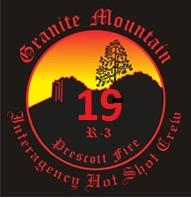By Leischen Stelter
Those who have made firefighting their career know what a dangerous commitment they have made. Particularly those who focus on fighting wildland fires understand the unpredictable nature of these fires and the environmental factors that can create instantaneous danger. Their respect for fire and their relentless training helps them be better firefighters, but as evidenced by the death of 19 elite firefighters killed while battling the Yarnell Hill fire in Arizona, even the most highly trained and most experienced firefighters are never free of danger.

The elite members of the Granite Mountain Hotshot Crew were on the fire line, attempting to contain the fire and protect property, when 19 of them were killed on June 30. How this elite group was caught in a situation forcing them to deploy their fire shelters—a last-resort effort to survive—remains unknown, but as all wildland firefighters know, conditions at these fires are always unpredictable and always dangerous.
I had a very somber conversation about the deaths of these best-of-the-best wildland firefighters with Pete Jensen, Captain with the Ventura County Fire Department in California. Jensen has fought hundreds of wildfires during his 24-year career. He started his firefighting career at the age of 21, working on a unit very similar to the Hotshot crew. “I worked on those crews and I know exactly what they were doing,” he said. “We would fly into fires and cut fire lines using chainsaws and shovels and it was very hard work, young man’s work. I have the utmost respect for them.”
Ventura County is one of the more active wildland fire departments in the nation and therefore very well connected within the wildland firefighting community. Thus, the loss of these 19 elite firefighters has taken a toll on them. “It’s really, really tragic for a group at this level of training to be decimated,” he said. “They’re like a SEAL team, they are an elite group, and to wipe out an entire SEAL unit is unheard of,” he said, comparing them to an elite specialized military unit. Interagency Hotshot Crews (IHC) are small, tight-knit teams with experienced leadership. Getting to this elite level of firefighting is an extremely challenging and rigorous process.
But, despite years of experience and training at this level, fighting wildland fires is highly unpredictable work. According to news reports, fire officials are saying that a highly volatile mix of erratic, gale-force winds, low humidity, an unprecedented regional heat wave, and an environment that had not burned in 40 years contributed to the death of these firefighters. The crew was caught in-between two fires as powerful gusts split the fire, driving it in two directions and pushing the fire back on them, Peter Andersen, a former Yarnell fire chief who was helping the firefighting effort told news outlets.
This type of environmental conditions leads to sporadic fire behavior that just cannot be predicted, said Jensen. “I’ve been on a number of wildland fires in my career and I’ve had a few situations where there’s been a drastic weather change or a combination of things happen where fuels are so dry and the slope is steep enough that as heat rises it’s blowing embers a quarter of a mile to a mile ahead. Now you’re caught in-between the main fire and the spot fires that are starting,” he said. “It’s a very dangerous situation. The fire behavior or the weather or the topography can make it really unpredictable.”
As wildland firefighters mourn the loss of these 19 elite brethren, they will also continue fighting wildfires, putting themselves in potentially dangerous situations to protect people and property and doing exactly what this Hotshot crew would want them to do.
A special tribute to those fallen firefighters who were identified as Andrew Ashcraft, 29; Robert Caldwell, 23; Travis Carter, 31; Dustin Deford, 24; Christopher MacKenzie, 30; Eric Marsh, 43; Grant McKee, 21; Sean Misner, 26; Scott Norris, 28; Wade Parker, 22; John Percin, 24; Anthony Rose, 23; Jesse Steed, 36; Joe Thurston, 32; Travis Turbyfill, 27; William Warneke, 25; Clayton Whitted, 28; Kevin Woyjeck, 21; and Garret Zuppiger, 27.
Comments are closed.